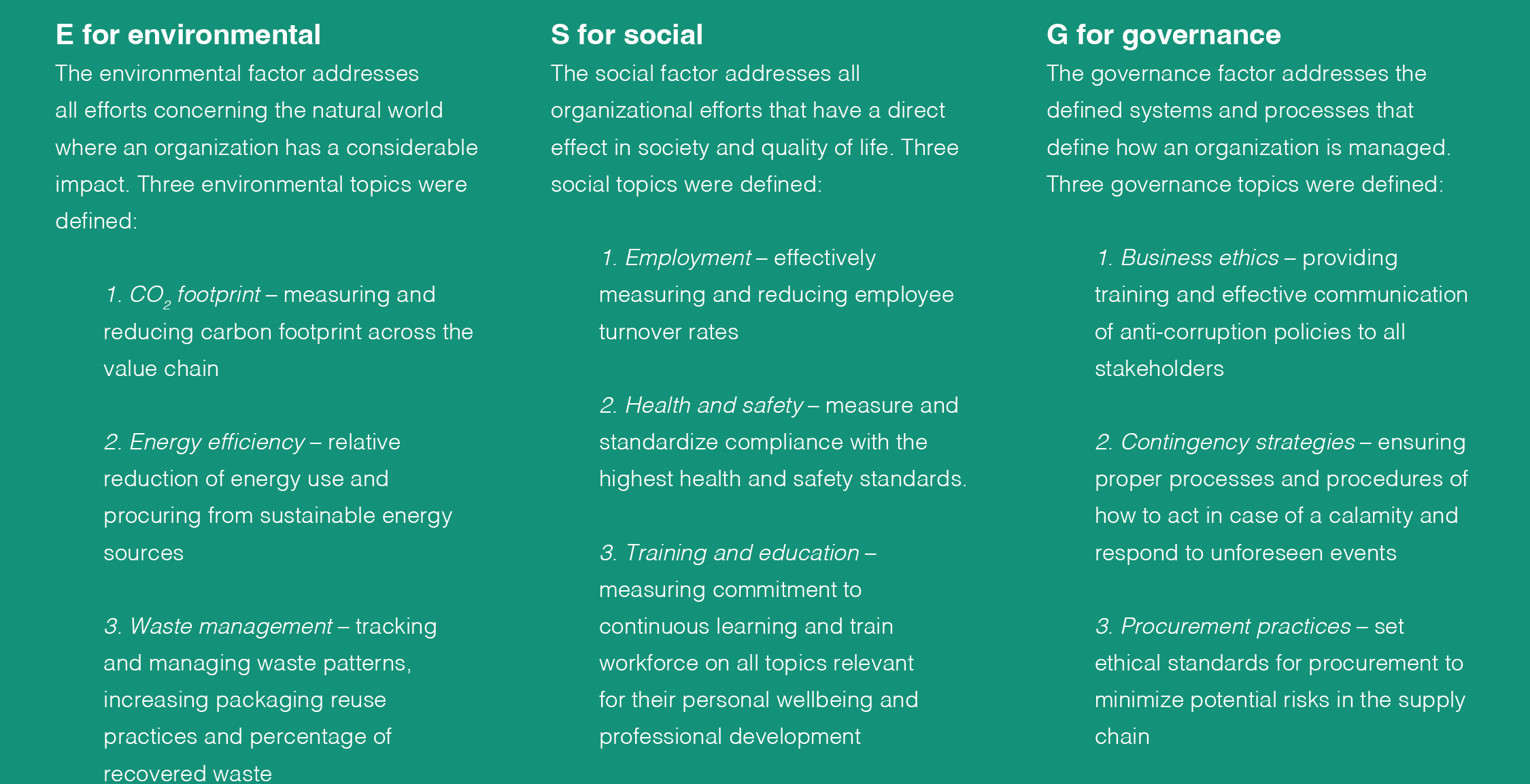THE CORNERSTONE OF SUSTAINABILITY
Designing a sustainability program for the manufacturing industry

In a planet of 8 billion people the threat of climate change in a post-pandemic era has only heightened awareness of Earth’s limited resources and how its delicate systems can easily be disrupted by human influence(1). The topic of sustainability has become a critical influence for strategic corporate policies all over the world. A business cannot survive in the current market without addressing sustainability in their operations.
In the Netherlands, industry employs 15.82% of the population, a whole 7% more than global standards(2). The manufacturing industry is not only responsible for providing steady stream of employment, but also responds to consumer demands by making essential products and services available. On the other hand, it is also responsible for one fifth of carbon emissions on a global scale and consume 54% of the world’s energy sources(3). The manufacturing industry plays a very important role in accelerating climate change, and as such, should be driving efforts to mitigate its effects. As a result, manufacturers all around the world are now under pressure to comply to new policies and incorporate sustainable practices into their operations. But, where to start?
Defining an ESG strategy
An Environmental, Social, and Governance (ESG) strategy aims to define corporate sustainability efforts in three areas. It incorporates relevant topics into a framework that will help stakeholders understand how an organization manages risks and opportunities. ESG strategies are a growing business trend that improves on and expands the scope of the already defined Corporate Social Responsibility (CSR) framework.
Companies with an ESG strategy are more likely to create value and outperform in the present market(4). A manufacturing company should define an ESG Strategy measures corporate sustainable initiatives, translates them into indicators, and drives improvement. An ESG strategy is a set of topics categorized into the three ESG areas. Each topic has a set of sub-topics with specific data collection requirements, measurement procedures, and resulting indicators that can be acted upon.

A sustainability program for the manufacturing industry
Corporate sustainability should start somewhere, and by establishing a working baseline for data collection and measurement, a company can begin to manage sustainability projects and address sustainability concerns. The following program was designed to meet the most pressing topics for manufacturing industries in the Netherlands.
Three topics were defined per ESG area and are briefly explained below:

An ESG strategy is largely based on the three pillars of sustainability: planet, people, profit. The three areas are not mutually exclusive and changes in one area will inevitably have an impact in the other areas. Balancing efforts across all topics is key to achieve true sustainability.
The Corporate Sustainability Reporting Directive
Sustainability as a concept aims to create awareness and incite actions that hinder the effects of climate change. Global efforts to mitigate the effects of global warming have evolved into new policies and legislations that have a large-scale impact. As of 2025, all businesses operating within the European Union regardless of size must report their activities according to standardized guidelines and requirements5. Companies must not only disclose financial performance, but how it is related to their environmental and social impact. A part of measuring that impact is expressed in forward looking targets in all ESG areas. The reporting organization must be able to prove that their sustainability practices align with their business model, strategy, and internal policies. The sustainability program is not only aligned with these requirements but is already incorporating the baseline for reporting according the CSRD guidelines.
The United Nations Sustainable Development Goals
As part of their 2030 agenda for sustainable development, the United Nations member states have agreed on 17 goals that will guarantee a better future(6). These goals are meant to be used as a common language that reflects the interests of all stakeholders, from individuals to large organizations. While the goals and their specific targets are based on global standards, no single organization is expected to contribute actively to all goals and targets. The goals that most closely relate to the manufacturing industry and are easily achievable are:
Goal 8: Decent work and economic growth
The manufacturing industry in the Netherlands is responsible for a large part of the economy. Providing decent, inclusive, and productive work is essential for economic growth.
Goal 9: Industry, innovation, and infrastructure
Promoting sustainable industrialization requires resilient infrastructure and fostering innovation. There are large economic and social benefits through innovative sustainability projects.
Goal 12: Responsible consumption and production
Worldwide consumption and production patterns drive global economy. As such, efficient use of natural resources is essential to mitigate the manufacturing industry’s negative impact on the planet.
Goal 13: Climate action
The manufacturing industry is one of the first affected by the consequences of climate change. This goal addressed any activities that involve taking urgent action to mitigate its effects.
The manufacturing industry employs thousands of people from the Netherlands and other foreign countries, providing them with decent work and remuneration as per Dutch standards (Goal 8). Industry has the potential to promote new technologies and fuel sustainability in manufacturing through innovation (Goal 9). A sustainability program formalizes current and future efforts to improve energetic consumption and waste patterns (Goal 12). And finally, environmental initiatives and targets such as transitioning to sustainable energy sources will ensure a 45% reduction in carbon emissions by 2030 (Goal 13).
The challenges of sustainability
Designing a sustainability program for a manufacturing company with global operations comes with challenges. Because sustainability can be such a broad topic, narrowing the scope to address topics that are not only relevant but measurable can be a challenge. Defining the key organizations and initiatives that will drive global policy in a world where everyone is pushing their own version of sustainability can be another challenge. Setting a direction for sustainability that is broad enough to be considered complete and overarching without setting the scope too broad that it becomes unmanageable is probably the most pressing challenge. Challenges will come and go with any new venture that requires adjusting certain practices and prioritizing key aspects within operations. Recognizing those challenges can only reflect positively on organizations, as it is a direct result of true transformative efforts.
Conclusion
Nevertheless, sustainability may look different for every company even if their business is in the same industry. The scope and operational capabilities may vary immensely, but it must be guided by the right mindset and vision. No single solution will work for everyone but having a baseline for future sustainable developments is a necessary first step. The results of the data collection for the first year will bring useful insights for further improving and expanding the sustainability program. It may also highlight practical issues that might require reassessment of certain indicators. No singular sustainability program is fool proof. Only by measuring, testing, and improving might the manufacturing industry find an effective path towards true sustainability. All companies should start somewhere, and the time to start was yesterday.
Sources
1. United Nations. (2022, November 15). Day of 8 Billion. https://www.un.org/en/dayof8billion
2. Trading Economics. (2023). Netherlands – Employment In Industry (% Of Total Employment) – 2023 Data 2024 Forecast 1969-2020 Historical. https://tradingeconomics.com/netherlands/employment-in-industry-percent-of-total-employment-wb-data.html
3. World Economic Forum. (2022, March 23). Reducing the carbon footprint of the manufacturing industry through data sharing. https://www.weforum.org/impact/carbon-footprint-manufacturing-industry/
4. Corporate Governance Institute. (2022). Companies with strong ESG perform better. https://www.thecorporategovernanceinstitute.com/insights/news-analysis/companies-with-good-esg-perform-better/
5. European Parliament and Council. (2022). Directive (EU) 2022/2464. On corporate sustainability reporting. https://eur-lex.europa.eu/eli/dir/2022/2464/oj
6. United Nations. (2023). The 17 Goals. https://sdgs.un.org/goals
